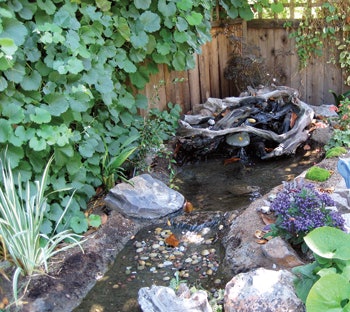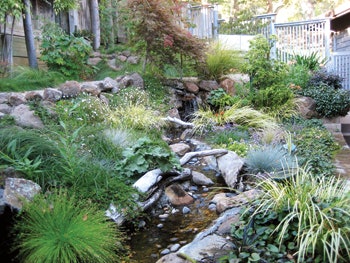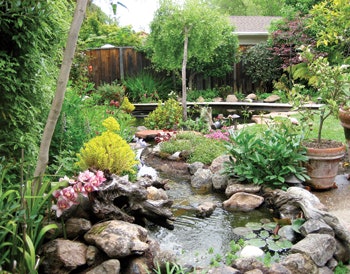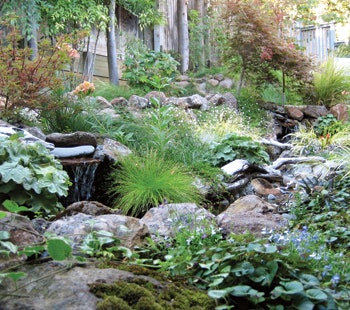
According to landscape artist Rick Driemeyer, of Both Sides of the Door (Oakland, Calif.), working in small spaces requires understanding scale, texture, movement and oftentimes, the clever use of water. It’s a specialty, he says, that can test the mettle of the best designers and one that is rightfully considered an art all its own.
When you talk about working in small spaces, to some extent, it really does depend on your definition of small. To some people, anything under an acre would be considered small; for others it’s much less than that.
In my work, I would say that probably 30 to 40 percent of my projects are in areas that I personally consider small. In many cases, I’ve designed and installed gardens for commercial clients on tiny plots of land tucked between buildings or along sidewalks where there’s a desire for a small garden area. I recently completed a so-called “pocket park” in an urban area that was only 10 by 15 feet — small by anyone’s measure.
On the residential end, I’ve worked in small courtyards, side yards or backyards where the house takes up most of the lot. Whether by design or circumstance, we live in an era where many people have small portions of land that they’d like to see treated with the same creative care that you find in larger gardens.

WELCOME CHALLENGE
I enjoy working on a small scale because it’s always interesting to try to meet the client’s needs in a tiny area. And make no mistake, there are times when some clients will want 10 different things happening in a 20-by-20-foot space, or less. That list might include flowering plants, a walkway, fragrance, a place to relax, the sights and sounds of running water, rockwork, privacy, garden art, a habitat for critters and an herb garden among other things.
That can seem daunting at first and sometimes you do have to moderate client expectations, but most of the time I find that when you break it down and think things through carefully, you can achieve surprising results in small spaces.
As an example, I recently created a garden for a client in an area that was 50 feet long by nine feet wide. Within that narrow sliver of land this client wanted a stream, a patio, a potting bench, a garden area and privacy. I really had to step up and figure how I was going to make all that happen and have it look harmonious. It took effort and the use of almost every square inch, but amazingly, we managed to give her what she wanted and create the illusion that the elements weren’t all jammed in on top of each other.
One of the keys to working in these confined quarters is to understand that you’re still trying to do the same things that take place over larger areas, only on a smaller scale. That means working with contrasting colors, different textures, layered views, areas of light and shadow, and a sense of motion, both in terms of views and how someone physically moves through the area.
EYE MOVEMENT
All of that’s possible, so long as you keep everything scaled down so that nothing becomes overly dominating. If you keep proportion in mind, you can come close to doing everything that’s possible in a larger area. Sometimes it’s a matter of finding the right plant or rock; sometimes it’s a matter of finding an interesting way to direct your eye or even create an illusion of space.
For example, I created a small tea garden with a pond in a space about 25 feet in length, but at the far end of the garden I located a mirror in the plantings so that when you looked out over the pond and garden from the teahouse, it appears as though the space goes on much farther than it really does. Even if you know there’s a mirror there, you don’t notice it, but instead simply feel that you’re in a space that extends beyond your view.
Aside from that kind of deliberate illusion, you have to find ways to move the eyes around, so that someone in the space is not focusing on the limits of the garden but all of the things going on within it. You try to create rooms or areas within the area that give the visitor a variety of sensory experiences from different points of view.
Again, that’s similar in many respects to what happens in larger areas where you create garden rooms and focal points. You might have a rock formation at one end that transitions into a stream that in turn leads your eye to a group of layered plantings that partially conceal a seating area. Perhaps there’s a pathway that leads you to the sound of moving water or beneath the shade of a small tree.
However you do it, you’re trying to create a sense of intimacy that adds significance and interest. By contrast a small space that has only lawn with plantings on the perimeter doesn’t reward you. Someone will walk though an area like that and barely notice it at all. There’s no reason to stay, whereas an area that has different features or rooms within in it invites you stay and regard the details more closely.


EASTERN INFLUENCE
The rich tradition of Japanese gardens provides great examples of what can be achieved in small spaces. In most Japanese gardens, which are often quite small, there’s a directional flow where you’re lead through the garden and not asked to experience everything at one time. A great example is a Bonsai tree — you can look at it very closely and see all kinds of interesting detail to the point where you think that it should be much larger, but yet it might be less than a foot tall. You’re drawn into it because it rewards close examination. You’re not thinking about how small it is, but how interesting and beautiful it is.
In the same sense, the Japanese maple is a plant that works beautifully in small applications. They have intricate foliage that you can open up in layers, creating the illusion that it’s something you might see driving down the road that’s 60 feet tall, when it’s only 10 feet tall. It’s not the size, but the beauty and delicacy that makes you want to stop and look more closely.
Japanese gardens teach us a great deal about garden design, in both small and large spaces. At the core it’s all about spatial relationships, how the garden relates to the entry and the exit, the movement within the space, the interaction with water, or the plantings, the rockwork, the pathways, and the layering of views.
Effective design is not about having one thing jump out at you and dominate the area, but about creating transitions that create interest by way of movement, contrast and harmony — by both the unity between elements, and their differences. It’s about achieving peaceful transitions; there’s no abruptness on one hand, yet no monotony on the other.
In small spaces, you’re always looking to take advantage of existing elements within the setting that can assist you in creating visual movement and those harmonious and interesting transitions. In many cases, for example, there are distant views that you can use to draw the eyes beyond the boundaries of the space itself. Perhaps it’s a line of trees adjacent to the property or distant hillsides or mountains. I always play off those elements as much as I can and use them to help give the illusion that it’s part of the space even though it’s not.
LOVELY LAYERS
One of the most important design principles, which applies to all spaces, large and small, is the layering of views. Layering is achieved by way of using different types of plants materials, elevations, stone, water and architectural elements so that they appear to both conceal and reveal something beyond the view. Layers create interest, a sense of mystery and the feeling of being rewarded for looking more closely.
Through layering you can motivate someone to explore the garden without them even knowing it. If you stop and look at a landscape or a view of some kind that you find interesting, you’re very likely looking at layers where elements in the foreground transition gradually to more distant views causing you to travel visually and perhaps even lead you to move physically into that view.
That can happen within a few feet or it can take place over miles.
That same principle works with barriers, such as fences, gates or stands of foliage. I’m not a fan of solid visual barriers because they’re not inviting. By contrast, if you look at fencing treatments you can see through you’re enticed to think about what’s beyond the fence because you can see part of it on the other side. There’s an almost seductive quality to seeing part of something that makes you imagine what the rest of it looks like.
That sense of mystery can be greatly enhanced when you hear the sound of moving water that’s just beyond your view, whether you’re walking by a space or moving within it. The gentle sound of a stream or waterfall almost always draws you towards it while creating an aura of tranquility and the promise of a reward when you finally see the source of that sound.

THE LIFE OF WATER
Last, but certainly not least, we come to an extremely important element — the presence of water.
In my view, water is the heart of the garden. No other element generates more interest, directs the eye or provides a sense of vitality more than water. That’s why, whenever possible I, include some type of water feature, whether it’s a small fountain, stream, waterfall or pond combination. There’s so much you can do with water — you can create a sense of motion with moving water or peaceful reflections with quiescent water; and of course you can do so much with its lovely sound.
In my work, I’m constantly aware that water is the element that will draw fauna into the environment, be they birds, invertebrates, amphibians or small mammals. If you look closely, you’ll see a constant pageant unfolding in and around the water, the sound of frogs croaking, the hovering of dragonflies, and especially the delightful spectacle of birds bathing, sometimes waiting in line to take their turn splashing in a small shallow stream.
Often times, the presence of animal life is something that comes as a surprise to my clients, and in some cases it becomes almost an obsession, especially for those who love birds. You can always attract birds with feeders, but if you really want them to come around, there’s nothing like a small stream to entice them into your yard.
And, of course, there’s the possibility of having fish, an entire subject unto itself. Ponds that contain fish are among the most interesting of garden elements. Raising koi, for example, is an obsession for some people with their vivid colors and gregarious personalities.
Water also provides a wonderful set of opportunities to blend elements of stone and plantings along its edges, or provide places for people to sit, relax and regard their surroundings. It can be used to generate interesting reflections of surrounding plantings or shimmering effects in sunlight or at night with landscape lighting as the water dances in the ripples of a stream or ribbons of a waterfall.
UNLIMITED POTENTIAL
If there’s one thing to take away from this discussion, it’s that with a thoughtful approach small spaces encompass far more potential that you may think.
Certainly, there’s no substitute for the grandeur of nature and expanses of undisturbed landscapes. Yet in our daily lives, in our man-made environments, using the small areas in an artful and soulful way, we can certainly make the day-to-day rigors more enjoyable by bringing the beauty of nature closer.
Comments or thoughts on this article?Please e-mail [email protected].











































